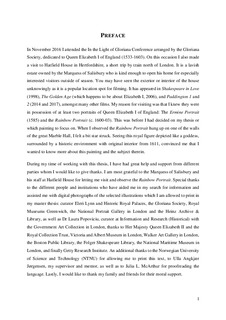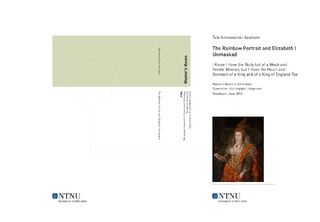| dc.contributor.author | Aasheim, Tale Annesdatter | |
| dc.date.accessioned | 2018-06-27T12:30:56Z | |
| dc.date.available | 2018-06-27T12:30:56Z | |
| dc.date.issued | 2018 | |
| dc.identifier.uri | http://hdl.handle.net/11250/2503326 | |
| dc.description.abstract | Denne masteroppgaven, "The Rainbow Portrait and Elizabeth I Unmasked - I Know I Have the Body but of a Weak and Feeble Woman, but I Have the Heart and Stomach of a King and of a King of England Too" (2018), argumenterer for at Rainbow Portrait (ca. 1600-03) er en sann representasjon av Elisabeth I (1533-1603) i hennes stilling som dronning av England, basert på de allegorisk og symbolske elementene som er å se. Dette er i kontrast til en mer naturalistisk representasjon som en sann eller realistisk tilnærmet likhet. Slik portrettet innehar nesten alle mulige allegorier og symbolske elementer i en stor blanding som representerer kongens todelte kropp, Elisabeths politikk og hennes styre, gjør dette til det ultimate statsportrett. Portrettet kan derfor anses som en oppsummering av Elisabeths makt og blir i tillegg et symbol på hennes regjeringstid som Englands gullalder. Ved bruken av mask of youth og en fremstilling av Elisabeth som en gudinne, forsvinner ethvert temporale spor slik at portrettet på en måte viser både begynnelsen og slutten på hennes regjeringstid samtidig. I sammenligning med hennes andre statsportretter, opphøyer Rainbow Portrait Elisabeth til en slags fantasifigur verdig tilbedelse, med dets iboende mystiske ikonografi og den merkelige kostymekombinasjonen. Et annet viktig aspekt i henhold til analysen av portrettet gjelder eksisterende dokumentbevis som tar for seg to sammenkomster i 1602: den første ved Harefield House mellom 31. juli og 2. august, og den andre ved Salisbury House 6. desember. Diktene skrevet av poeten Sir John Davies (1569-1626) ved begge anledningene har en direkte forbindelse med portrettets ikonografi, en ikonografi som sannsynligvis ble designet i samarbeid med dets mesen, Sir Robert Cecil, 1. jarl av Salisbury (1563-1612). Dette avgjørende forholdet mellom tekst og bilde var viktig i konstruksjonen av motiv i renessansemaleri. Som med tekst var maleri ment å bli lest heller enn bare betraktet. Teksten i dette tilfellet blir et hjelpemiddel i lesningen av den språklige fortellingen, meningen, inneværende i maleriet. Klesteori er også utforsket i denne masteroppgaven i henhold til den nylige gjenoppdagelsen av alterduken fra Bacton Parish Church som et mulig klesplagg tidligere eid og båret av selve Elisabeth. Alterduken kan til og med være laget av det samme stoffet som livstykket Elizabeth har på seg i portrettet. I denne teksten er Rainbow Portrait ikke bare et studieobjekt, men er også hoved primærkilden. Den er ikke bare analysert som et objekt i seg selv. Den er også brukt som kilde for å skape et innblikk i samtidens meninger og politisk tankegang i tillegg til allegoriske fortolkninger. Analysen følger den tradisjonelle tredelte ikonografiske og ikonologiske analysemetoden til Erwin Panofsky (1892-1968), fritt brukt utover kapitlene. | nb_NO |
| dc.description.abstract | This master’s thesis, "The Rainbow Portrait and Elizabeth I Unmasked - I Know I Have the Body but of a Weak and Feeble Woman, but I Have the Heart and Stomach of a King and of a King of England Too" (2018), argues that the Rainbow Portrait (c. 1600-03) is a true representation of Elizabeth I (1533-1603) in her position as the Queen of England, based on the allegorical and symbolical elements therein. This in contrast to a more naturalistic representation as a true or realistic likeness. The way the portrait has incorporated almost every possible allegory and symbolism in one great amalgamate representing the king’s two bodies, Elizabeth’s politics, and her reign, makes it the ultimate state portrait. The portrait can therefore be considered as a summary of Elizabeth’s power and becomes a symbol of her rule as the golden age of England. With the use of the mask of youth as well as depicting Elizabeth like a goddess, any temporal trace is removed so that the portrait in a way shows both the beginning and the end of her reign simultaneously. Compared to her other state portraits, the Rainbow Portrait, with its mystical iconography and the strange combination of costume, elevates Elizabeth into a fantastic figure worthy of worship. Another crucial aspect to the analysis of the portrait is related to any documentary evidence of two entertainments of 1602: the first at Harefield House between 31 July and 2 August, and the second at Salisbury House on 6 December. The poems written by the poet Sir John Davies (1569-1626) for these events have a direct connection with the iconography of the portrait, an iconography probably designed in collaboration with its patron, Sir Robert Cecil 1st, Earl of Salisbury (1563-1612). The significant relationship between text and image was of great importance in the construction of imagery in Renaissance painting. As with texts, paintings were supposed to be read rather than just viewed. The text in this circumstance aids the linguistic story, the meaning, within the painting. The theory of dress is also explored in this master’s thesis, regarding the recent rediscovery of the Bacton Altar Cloth as a possible garment owned and worn by Elizabeth herself. The cloth might even be of the same fabric as that of the bodice Elizabeth wears in the portrait. In this text, the Rainbow Portrait is not only an object of study but is also the main contemporary source. It is not only analysed as an object by itself. It is also used as a source to explain contemporary views and political beliefs as well as allegorical interpretations. The analysis follows the traditional three levels of iconographic and iconological analysis of Erwin Panofsky (1892-1968), though freely employed across the chapters. | nb_NO |
| dc.language.iso | eng | nb_NO |
| dc.publisher | NTNU | nb_NO |
| dc.subject | Elisabeth I, Elizabeth I, Rainbow Portrait, portrett, renessansemaleri, mask of youth, king's two bodies, Astraea, John Davies, Robert Cecil, Hatfield House, Harefield House, Salisbury House | nb_NO |
| dc.title | The Rainbow Portrait and Elizabeth I Unmasked - I Know I Have the Body but of a Weak and Feeble Woman, but I Have the Heart and Stomach of a King and of a King of England Too | nb_NO |
| dc.type | Master thesis | nb_NO |
| dc.subject.nsi | VDP::Humaniora: 000 | nb_NO |

